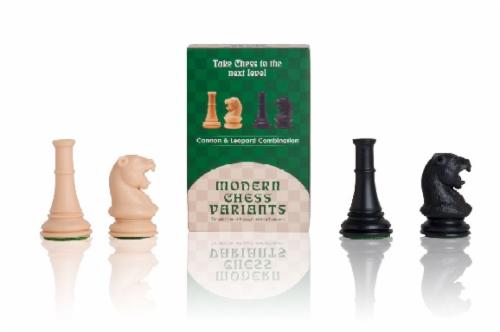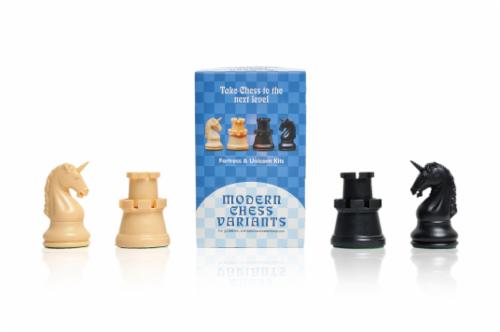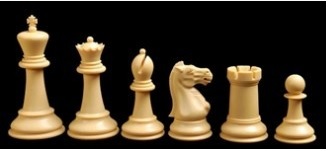
Rules for Musketeer Chess 1.0
Setup
Musketeer Chess is played on an 8x8 chess board with the addition of rows 0 and 9 for some pieces temporary storage.

Each player will play with the usual 16 chess pieces + 2 identical musketeer pieces.
There are 10 musketeer pieces: Leopard, Hawk, Chancellor, Archbishop, Elephant, Unicorn, Cannon, Dragon, Fortress and Spider.

Step 1: first musketeer piece selection

White chooses the first Musketeer piece by positionning it on the white start position labled "1". The same black piece is automatically moved to black start position "1".
Step 2: second musketeer piece selection
Black has 2 possibilities:
- chooses the second musketeer piece among the 9 remaining possibilities by positionning it on the black start position labled "2".
- refuses white choice by putting the first selected piece back to its original position. In this case, the 2 musketeer pieces will be Cannon and Leopard.
Step 3: placing musketeer pieces

- White places his 1st musketeer piece on row 0.
- Black places his 1st musketeer piece on row 9.
- White places his 2nd musketeer piece on row 0.
- Black places his 2nd musketeer piece on row 9.
Exception: you can not place one musketeer piece behind a rook and the other behind the king.
Step 4: play time
Standard chess rules apply for classic pieces.
Musketeer pieces enter the game when the position right in front of them is freed by a move. If the piece in front of a musketeer piece is captured before it entered the game, the musketeer piece is also removed from the board.
Musketeer pieces moves
 When appears, this means that the piece reaches the square by jumping from its original square to the marked square (similar to a knight, for example).
When appears, this means that the piece reaches the square by jumping from its original square to the marked square (similar to a knight, for example).
This piece is called a “leaper”, jumping over any other man in the adjacent squares (it can jump over its own men or enemy pieces). Enemy pieces are captured only if they lie on one of the squares controlled by the new piece.
 When appears, this means that the square is reached by a “sweeping” movement.
When appears, this means that the square is reached by a “sweeping” movement.
The new piece moves through an unobstructed, defined path. It moves along the path indicated if there is no obstacle in its way.
The shape of the path (or line) is not necessarily diagonal or orthogonal (please see the Fortress rules). When the path is obstructed by another piece, then our new piece is blocked in the square before the blocking piece, unless the obstructing piece is the enemy. The blocking piece can be captured. Our new pieces ends her path on the square of the captured piece.
Leopard
The Leopard is a new piece that combines moves of a Knight and a Bishop with a limited range of 2 squares. Compared to Archbishop (Bishop and Knight), it’s a less powerful piece, but this limited Bishop range adds interesting strategical components and sharpens the game with many tactics.

The Leopard cannot move orthogonally. It can control a maximum of 16 squares. Compared to the Cannon (see below), it has almost the same value, but it appears to be slightly more aggressive, as it has the ability to “sweep” forward more squares. It can checkmate a bare king without help.
From d4, the Leopard can control 16 squares: It can leap to c2, b3, e2, f3, b5, c6, e6, f5. It slides to: c3, b2, c5, b6, e5, f6, e3, f2.
PGN Notation : Le
Cannon
The Cannon moves differently than the Cannon in Xiangqi, but it can be used for a western chess set to mimic games played in China and Japan.

From d4, the Cannon can control 16 squares: It can leap to d2, d6, b4, b3, b5, f4, f3, f5, It slides to: c3, c4, c5, d3, d5, e3, e4, e5.
PGN Notation : Ca
Unicorn
The Unicorn is an enhanced version of the Classic Chess Knight. It moves like a Knight but has expanded jumping capabilities.
It can move like the knight (1+2 or 2+1), but it can also “jump” like an extended knight (1+3 or 3+1). It controls 16 squares.

The Unicorn from d4 can control 16 squares: It can leap to c2,c1, c6, c7, b3, a3, b5, a5, e6, e7, f5, g5, f3, g3.
PGN Notation : U
Dragon
The Dragon combines powers of a Queen and a Knight. It exists in many chess variants and is known by other names such as Amazon, Commander. It is among the most powerful pieces of the known chess variants. The Dragon top is pegged and can be removed (to handle with care).

From d4, the Dragon can control a total of 36 squares.
PGN Notation : Dr
Chancellor
The Chancellor can move like a Rook or a Knight.

From d4, the Chancellor can control a total of 22 squares.
PGN Notation : Ch
Archbishop
The Archbishop can move like a Bishop and a Knight. It can checkmate without any help.

From d4, the Archbishop can control a total of 22 squares.
PGN Notation : Ar
Elephant
Similar to the King, the Elephant can move one square in all directions. It also leaps orthogonally or diagonally by 2 squares.
The Elephant is described in some historic Chess Variants such as Xiangqi, but also in the majority of the Chess Variants where it was used. This piece was most of the time of limited range and is a very weak piece (Shogi, Xiangqi, Shatranj, Shako, Courier Spiel, etc.). In Musketeer Chess, the Elephant is much stronger, controlling 16 squares and can mate a lone King single-handedly.

From d4, It can leap to d6, d2, b2, b4, b6, f2, f4, f6. It slides to: d5, d3, c3, c4, c5, e3, e4, e5.
PGN Notation : E
Hawk
The Hawk is a pure leaper. In Musketeer Chess, the Hawk attacks by jumping over pieces 2 to 3 squares orthogonally or diagonally in any direction. The Hawk is a dangerous piece, but it’s also vulnerable as it cannot protect itself from the short range attacking pieces. You can imagine attacking the opponent king at the opening (especially before castling) with mating patterns.

The Hawk can control up-to a total of 16 squares: From d4, it can leap to b2, a1, b4, a4, b6, a7, d2, d1, d6, d7, f2, f4, f6, g1,g4,g7.
PGN Notation : H
Fortress
The Fortress is another heavy piece with different capabilities from the already available chess variants.
It can move in an unobstructed path, sliding diagonally in any direction, but limited to a maximum of 3 squares (for example from f1 it can slide to e2, d3, c4, g2 and h3 but cannot reach b5 or a6).
The Fortress can also “jump” like a Knight only 2 squares vertically and 1 square horizontally (from f1 it reaches g3 and e3 but cannot jump to h2 and d2).
The Fortress can also “jump” in any direction vertically or horizontally by two squares (from e3 it can jump to c3, g3, e5 and e1).
The top tower of the Fortress is pegged, so that the tops of the light and dark units can be interchanged (to handle with care).

From d4, the Fortress can control 20 squares: It can slide to e3, f2, g1, e5, f6, g7, f8, c3, b2, a1, c5, b6, a7. It can “jump” to: d6, d2, b4, f4 and c6, c2, e6, e2.
PGN Notation : Fo
Spider
A map of the moves that are possible with the next variant reminds one of the web made by a Spider, hence its name – Spider.
It can move in an unobstructed path, sliding diagonally in any direction, but limited to two squares.
The Spider can also “jump” like a Knight. It can also “jump” in any direction vertically or horizontally by two squares.
When starting from h1 for example, it can move to g2, f3. It can also “jump” to h3, g3 f1 and f2.
The top of the Spider is pegged, offering the possibility of creating two different variants with different moves (to handle with care).

When starting from d4, it can control 20 squares: sliding to e5, f6, e3, f2, c5, b6, c3, b2. It can “jump” towards: c6, b5, c2, b3, e6, f5, e2, f3, d6, d2, b4, f4.
PGN Notation : Sp
Commercial Links
 Musketeer Chess Leopard and Cannon Kit
Musketeer Chess Leopard and Cannon Kit
 Musketeer Chess Archbishop and Chancellor Kit (Camaratta or Fischer-Karpov Kit)
Musketeer Chess Archbishop and Chancellor Kit (Camaratta or Fischer-Karpov Kit)
 Musketeer Chess Elephant and Hawk Kit (Sharper Kit)
Musketeer Chess Elephant and Hawk Kit (Sharper Kit)
 Musketeer Chess Fortress and Unicorn Kit
Musketeer Chess Fortress and Unicorn Kit
 Musketeer Chess Dragon and Spider Kit
Musketeer Chess Dragon and Spider Kit

The Marshall series 3"75 King, triple weighted plastic chess set














